How to Brew the Perfect Cup of Coffee
Tristan Coulter of Chicago's Metropolis Coffee Explains the Pour-Over Technique
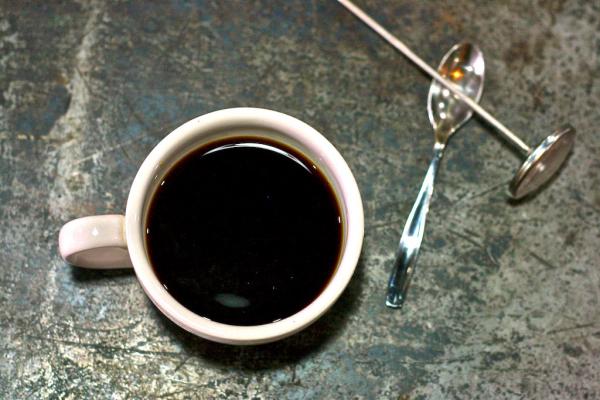
I discovered the first inklings of my obsessive nature while making coffee in college. So many things can go wrong. So many ways to go right off the cliff. What should be routine and pleasurable becomes stressful, maddening, disappointing. The beans, the water, the tools, the process, and the thin line between greatness and mediocrity. None are exempt from mistakes. And of course, no one has ingested any caffeine yet. And we know what kind of mood that puts people in.
I fell victim to this insanity for a number of years. I cycled through methods and gadgets like so many disposable filters. Vacuums, presses , gravity-defying machines . I melted espresso makers, shattered French presses, and consumed an entire stovetop Bialetti's worth of espresso every morning for a period of my life. The caffeine only enraged my desires further in a vicious cycle.
How could I enjoy a perfect cup of coffee? One that tastes intoxicating, sweet, rich, and subtle--just like it smells?
I suppose things have relaxed now; I'm more mature and I even drink milky black tea in the morning, thanks to my wife Elin's influence. She came back from England with an abiding faith in good tea, and it rubbed off. I'm a little less amped up and a lot more tolerable now.
But every day, at some point, I think about coffee. I am as interested as ever in techniques for making the perfect cup.

The pour-over technique would be laughable if so many devoted coffee drinkers--experts and connoisseurs--were behind it. Really? All I have to do is pour water over the coffee in a plastic cone?
No machinery or anything that has a switch, cord, beep or button, just a tremendously appealing simplicity and artfulness (it was popularized in Japan). Like most things resulting in perfection, it does require attention to detail, but it's not hard once you get it. It's meditative, and it makes you enjoy each and every cup you drink.
If you start with good beans, this is the most subtle coffee you've tasted in awhile, revealing characteristics like fruitiness, chocolate undertones, all that stuff you've pretended to notice in the past.
My friend Tristan Coulter Metropolis Coffee, which roasts their coffee in Chicago, walked me through the process step by step. He was quick to assure me that none of this is set in stone, but this is the way they do it at Metropolis. While there's always room for different methods, this is the result of some trial and error, and, judging from the cup of coffee I tried, it's excellent.
Pour-Over Coffee
- An electric scale
- A timer
- A coffee grinder*
- A single-cup drip coffee cone*
- A kettle*
- A single-cup paper coffee filter
- A brewing vessel (like a measuring cup)
*Grinders, drip cones, and kettles are not all made the same. Here are some recommended products, all by the same company, which is apparently the gold standard for pour-over things:
Burr grinders (not the electric kind that spins) can be expensive, but this one is handheld, compact, and has ceramic that won't wear out. Hario MSS-1B
The drip cone is a simple tool, but getting a good one with a proper shape is a good idea. Hario VDC-02W
The specialized kettle is the least important item to buy, but it does make a difference. With a spout that draw water from the bottom of the kettle, rather than the top, you get an even flow of water and great accuracy for where you point it. You'll see below why this matters. Hario Coffee Drip Kettle
Preparation
Fill a kettle with cold, filtered water and set it to boil. Set the cone on top of a brewing vessel.
While the water is coming to a boil, put a paper filter inside the cone, then rinse the filter with about 4 ounces of hot water (it doesn't have to be boiling; you could use a little of the kettle's water on the way to the boil). Two things are accomplished: heating the cone and rinsing out any residual paper flavor. It'll add a subtle flavor of wet paper towels if you don't. Pour out the water that has collected in the brewing vessel below.
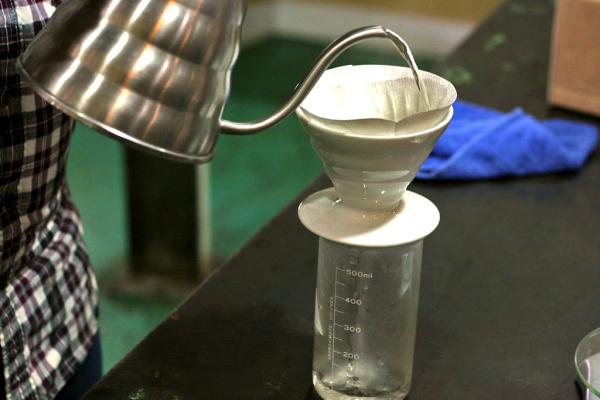
Grinding the Coffee
Measure out 32 grams of coffee beans and grind them to the consistency of granulated table sugar (the fineness of the grind determines not only how much is extracted, but also the speed with which the water passes through it).
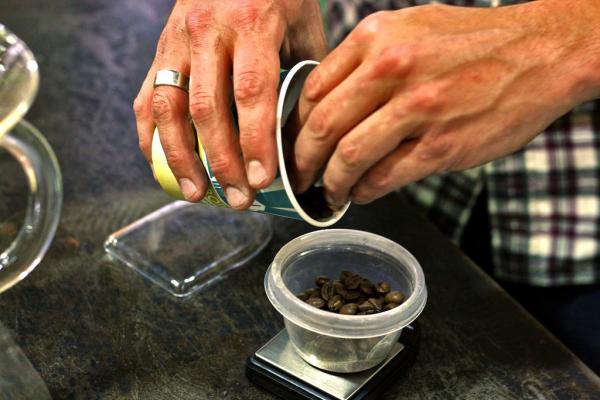
Place the cone and brewing vessel on top of an electric scale. Pour the grounds into the filter and reset (tare) the scale to zero.
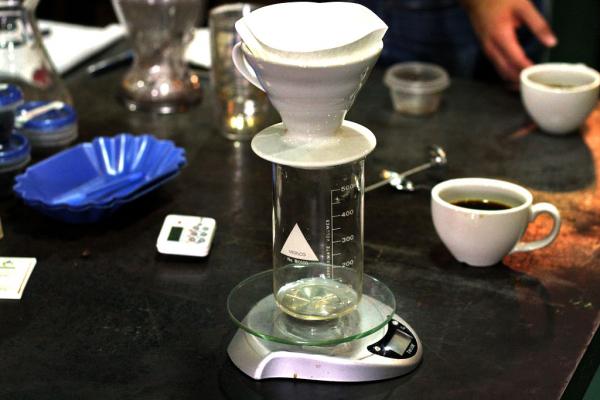
Blooming the Coffee
Once the water in the kettle is at a rolling boil, remove it from the heat and let it cool for 30-45 seconds, which is about enough time to get it to 205 degrees. 205 degrees is a little hotter than you want, but by the time it travels to the coffee, it will be ideal. Extremely detailed people would use a thermometer in this case, but that's pretty fastidious.
Carefully pour 55 grams of water over the grounds from a height (you want it to be a relatively aggressive pour), starting in the center and working your way out. Make sure that the grounds are evenly saturated; once the scale reads 55 grams , stop.
There shouldn't be much water that drips down; the coffee will absorb it. If water is coming through, you're using too much water, or the coffee is not ground finely enough.
Let the coffee sit for 30 seconds, which time the grounds will swell up a bit and "lock" into place. It also allows the cofee to "degas" and fully saturates the coffee bed, ensuring better flavor in the resulting cup.
Brewing the Coffee
Start a timer.
Pour in 100 more grams of water, so that the scale now reads 155 grams . Try to pour with slow precision (this is easier with the kettle linked to above) so that the grounds are evenly covered and not dislodged. You never want to pour onto the side because the finer grounds can get pushed down towards the smaller part of the funnel, choking the extraction. Aim at least 1/2 inch from the edges.
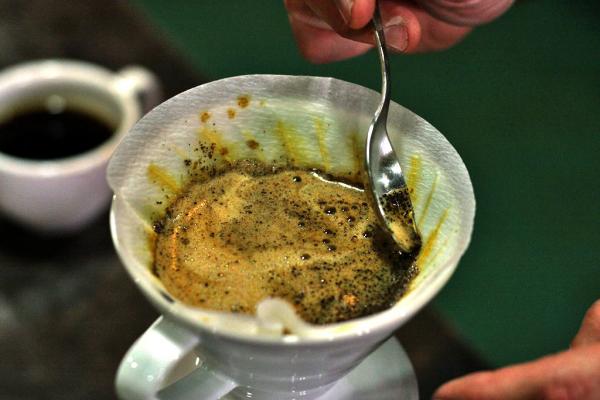
Use a spoon to push any stray cofee on the sides of the filter back into the water.
At the 2:00 mark, pour in another 100 grams, bringing the weight to 255 grams . At the end of each pour, push the bed back down. At 3:00, pour another 50 grams to total 305 grams .
At 3:30 pour in the final 50 grams to total 355 grams.
At 4:30 , the coffee should stop dripping, and the bed should be done draining. If there's still excess water, that probably means the grind was too fine. 4:30 is of course an estimation; 30 seconds or so give is okay. But it's a good ballpark.

Remove the cone, pour the coffee into a mug (be sure to warm the mug with some extra hot kettle water so it's toasty first) and enjoy.
Drinks, Burr mill, Caffeine, Coffea, Coffee, Coffee, Coffee, Coffee preparation, Coffeemaker, Drink, Drip brew, Elin, Espresso, Food and drink, French press, Kettle, machinery, Metropolis, Pour-Over, Soft matter, Tristan Coulter, Tristan Coulter Metropolis, United Kingdom

Comments:
Blog Comments powered by Disqus.